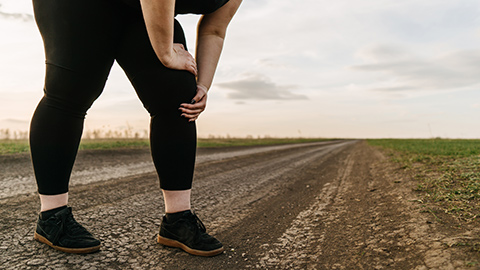09/25/2020

In this episode, a client has lipedema—a painful condition with enlarged fat cells that won’t ever shrink or go away by themselves, and it’s probably going to get worse. It turns out that massage therapy could be helpful with the right kind of education and background. Fortunately, we found a great resource!


This podcast sponsored by Books of Discovery and Anatomy Trains.
00:00 Speaker 1: Ruth Werner's best-selling book, A Massage Therapist's Guide to Pathology, is a highly regarded comprehensive resource that sets the standard for pathology education. Written for massage therapy students and practitioners, this groundbreaking resource serves up a comprehensive review of the pathophysiology, signs, symptoms, and treatment of more than 500 diseases and disorders. Learn more at booksofdiscovery.com.
[music]
00:39 Speaker 2: Hi, and welcome to I Have a Client Who, pathology conversations with Ruth Werner, the podcast where I will discuss your real life stories about clients with conditions that are perplexing or confusing. I'm Ruth Werner, author of A Massage Therapist's Guide to Pathology, and I have spent decades studying, writing about and teaching about where massage therapy intersects with diseases and conditions that might limit our client's health. We almost always have something good to offer even with our most challenged clients, but we need to figure out a way to do that safely, effectively, and within our scope of practice. And sometimes, as we have all learned, that is harder than it looks. This episode comes to us from a massage therapist who specializes in working with clients who have recently had plastic surgery, typically for medical rather than cosmetic reasons. The client is a woman with a condition called lipedema. This is a situation that I'll describe in a little bit, but to get us started, let's just understand that it can be painful, debilitating, and disfiguring. It affects women much more often than men, and it runs in families.
01:54 S2: And what this means is that for this client, because she watched her mother develop this condition, she had a sense of what was in store for her and she wanted to do anything she could to avoid it. So, the story goes like this. I have a client who is in her mid 50s with lipedema. She began a series of surgeries to help deal with the situation, and I was invited to do manual lymph drainage with her as she went through the process. Her goals were simply to be able to do the regular kinds of things that women of her age can usually do. I began working with her after the first of a series of liposuction surgeries, and I saw her twice a week as she went through more surgeries over the next two to three months. So I'm gonna pause here to say thank you so much to this massage therapist who generously shares her story about a client with lipedema. We're going to talk about what this condition is, what is currently understood about it and the role of massage therapy for people who live with it, and then we'll see what happened for this particular client.
03:00 S2: If you have a client whose story might help other massage therapists, I hope you'll share it. You can do that by sending it to me at ihaveaclientwho@abmp.com. That's ihaveaclientwho, all one word, all lower case @abmp.com. And now, let's talk about lipedema. Hormonal changes, puberty or pregnancy or menopause, most of the time we see it symmetrically in the legs. In this situation, the adipocytes of the superficial fascia get enlarged and inflamed, they're suspended in loose connective tissue, which then becomes thickened and fibrotic. People with this condition often find that it is painful and damage to small lymphatic and circulatory capillaries means that they bruise easily. Another term for lipedema is painful fat syndrome. There appears to be a strong genetic predisposition for this. As we've said, the client we're discussing watched her mother go through this process, and that is not at all unusual. This is also a progressive disorder, without treatment, it gets worse and worse, and ultimately it can be so painful and the legs can become so enlarged and distorted that it can be completely debilitating.
04:20 S2: When it becomes too hard to walk, people are forced to use wheelchairs and they often go downhill rapidly from there. Here are a few things lipedema isn't. It isn't obesity. People with lipedema can look like they are overweight because of this fluid retention in the lower half of their body, and lots of women with lipedema are told they're overweight and they should just diet and exercise, but the affected fat cells are essentially isolated from the rest of the body, they are not impacted by calorie restriction or exercise. I looked for some pictures of this condition, and I wanna let you know that some of them are very extreme and intense. So if you wanna do that, do it with caution. And there are examples of women who are virtually underweight above the waist and very enlarged due to lipedema below the waist. Lipedema isn't cellulite. Cellulite is a description of lumpy, uneven texture of the skin where subcutaneous fat is deep and connective tissue gets caught. Cellulite can be a symptom of lipedema, but it can also be a completely free-standing condition that is tied to overall full body weight, where lipedema is not.
05:38 S2: Lipedema isn't lymphedema. Lymphedema is also a situation with unhealthy fluid retention, but it's usually only on one side, and we are most likely to see it in the context of cancer or cancer treatment, because of damage to lymph nodes. Lipedema progresses through stages of severity like lymphedema, and it can develop into lymphedema, but these are not synonymous terms. There is some good-ish news about lipedema, which is that, while it is not technically curable, it is absolutely manageable. If it has progressed to the point where removal of these damaged fat cells is necessary, this can be accomplished through a series of liposuction procedures, this isn't the liposuction we see done to reduce the appearance of cellulite, this is much more aggressive and intense and it can cause extreme if temporary swelling. In addition to surgery, skilled manual lymphatic drainage and compression garments help to keep this situation under control. It's hard to know how many people live with lipedema, it's not a well-understood situation, and there is not universal agreement on how to recognize it or even how to treat it.
06:52 S2: But if you have women in your life who fit this description, then learning appropriate lymph drainage approaches to massage could be really helpful for them. Now, let's return to our client who has this condition, as we said, the liposuction that's done to treat lipedema is way more intense and invasive than what we see done for cosmetic surgery, and one of the consequences is that this can result in a lot of swelling, which is exactly what happened to this client. The massage therapist reports my client was extremely sensitive, she had massive swelling in her legs after some really gentle lymphatic cupping, she said, "Oh, my leg was talking to me after that last appointment," meaning, she was sure even with very gentle work. So, I had to pull way back until she could tolerate more pressure. But now it's a few months later, and what makes us both really happy is she can exercise what she could never do before, we talk about this with every appointment. She can walk further than she could before, she loves to do pool aerobics. Best of all, she was able to fly across the country and help her daughter move on to campus to start college, and this involved a lot of physical activity and lifting and reaching and carrying things.
08:06 S2: She could never have done that before she started treatment, and that's such a big improvement. Lipedema is a complicated situation, and not everyone agrees on what it is or how best to treat it, but we're in a better position today to help people with this condition, manage it successfully, so they have a great quality of life and are able to do the same kinds of activities as anyone else. Massage by itself is not an answer to this problem, but massage as part of an integrated set of strategies can be a big part of a solution. I'm really happy to share this success story with you, because I think lipedema is probably a lot more common than we think it is. And as we've seen, massage therapy could be helpful. As I dug into this topic, I was lucky to run across a real expert who helped a lot, and that's a woman named Kathleen Lisson, who's a massage therapist with advanced knowledge about this topic. So, if you're interested in working with clients who have lipedema, I recommend that you check out Kathleen's website. She's written a book on this topic. She offers continuing education classes, and all of this will be in the show notes for this episode.
09:15 S2: So that's just a little thumbnail sketch of lipedema, but I was so intrigued by just this little taste of the subject that I think I'll do a deeper dive in a pathology perspectives column in Massage & Bodywork Magazine soon. So, if you're interested, watch for that. Hey everybody, thanks for listening to I Have a Client Who pathology conversations with Ruth Werner. Remember, you can send me your I have a client who stories to ihaveaclientwho@abmp.com. That's ihaveaclientwho, all one word, all lowercase, @abmp.com. I can't wait to see what you send me, and I'll see you next time.
[music]
10:01 S1: Anatomy Trains is excited to announce a new on-demand video course with Tom Myers coming soon, deeper ground, restoration and vitality for the female pelvis, reach your deeper ground of embodied awareness and strategic confidence with this four-hour tour of the female pelvis, including its key points and unique challenges. Course highlights include hands-on palpation certainty and technique review for the major muscle groups, assessments and techniques for posterior and anterior pelvic floor, psoas complex and diaphragm, common perinatal biomechanical issues explained and much more. Sign up for the Anatomy Trains newsletter at anatomytrains.com to be notified when the course is available.





